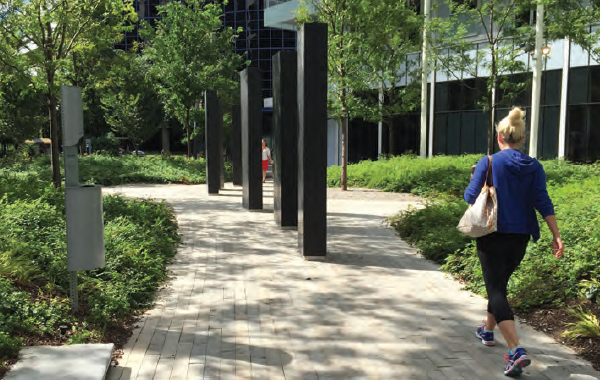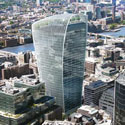Height rank
Tour Carpe Diem
Courbevoie
- CTBUH Drawing
- Facts
-
Metrics
You must be a CTBUH Member to view this resource.
To Tip:
Height is measured from the level of the lowest, significant, open-air, pedestrian entrance to the highest point of the building, irrespective of material or function of the highest element (i.e., including antennae, flagpoles, signage and other functional-technical equipment).Architectural:
Height is measured from the level of the lowest, significant, open-air, pedestrian entrance to the architectural top of the building, including spires, but not including antennae, signage, flag poles or other functional-technical equipment. This measurement is the most widely utilized and is employed to define the Council on Tall Buildings and Urban Habitat (CTBUH) rankings of the "World's Tallest Buildings."Occupied:
Height is measured from the level of the lowest, significant, open-air, pedestrian entrance to the highest occupied floor within the building.
Above Ground
The number of floors above ground should include the ground floor level and be the number of main floors above ground, including any significant mezzanine floors and major mechanical plant floors. Mechanical mezzanines should not be included if they have a significantly smaller floor area than the major floors below. Similarly, mechanical penthouses or plant rooms protruding above the general roof area should not be counted. Note: CTBUH floor counts may differ from published accounts, as it is common in some regions of the world for certain floor levels not to be included (e.g., the level 4, 14, 24, etc. in Hong Kong).Below Ground
The number of floors below ground should include all major floors located below the ground floor level.Official Name
Tour Carpe Diem
Type
Building
Status
Completed
Completion
2013
Country
City
Address
Function
A mixed-use tall building contains two or more functions (or uses), where each of the functions occupy a significant proportion of the tower's total space. Support areas such as car parks and mechanical plant space do not constitute mixed-use functions. Functions are denoted on CTBUH "Tallest Building" lists in descending order, e.g., "hotel/office" indicates hotel function above office function.
Office
Structural Material
Both the main vertical/lateral structural elements and the floor spanning systems are constructed from steel. Note that a building of steel construction with a floor system of concrete planks or concrete slab on top of steel beams is still considered an “all-steel” structure as the concrete elements are not acting as the primary structure.
All-Concrete
Both the main vertical/lateral structural elements and the floor spanning systems are constructed from concrete which has been cast in place and utilizes steel reinforcement bars and/or steel reinforced concrete which has been precast as individual components and assembled together on-site.
All-Timber
Both the main vertical/lateral structural elements and the floor spanning systems are constructed from timber. An all-timber structure may include the use of localized non-timber connections between timber elements. Note that a building of timber construction with a floor system of concrete planks or concrete slab on top of timber beams is still considered an “all-timber” structure as the concrete elements are not acting as the primary structure.
Mixed-Structure
Utilizes distinct systems (e.g. all-steel, all-concrete, all-timber), one on top of the other. For example, a Steel Over Concrete indicates an all-steel structural system located on top of an all-concrete structural system, with the opposite true of Concrete Over Steel.
Composite
A combination of materials (e.g. steel, concrete, timber) are used together in the main structural elements. Examples include buildings which utilize: steel columns with a floor system of reinforced concrete beams; a steel frame system with a concrete core; concrete-encased steel columns; concrete-filled steel tubes; etc. Where known, the CTBUH database breaks out the materials used within a composite building’s primary structural elements.
All-Concrete
Height
161.9 m / 531 ft
Floors Above Ground
36
Floors Below Ground
2
# of Parking Spaces
355
# of Elevators
13
Top Elevator Speed
6 m/s
Tower GFA
44,016 m² / 473,784 ft²
Rankings
-
By function
You must be a CTBUH Member to view this resource.
-
By material
You must be a CTBUH Member to view this resource.
Construction Schedule
Proposed
Construction Start
Completed
Developer
Architect
Usually involved in the front end design, with a "typical" condition being that of a leadership role through either Schematic Design or Design Development, and then a monitoring role through the CD and CA phases.
Usually takes on the balance of the architectural effort not executed by the "Design Architect," typically responsible for the construction documents, conforming to local codes, etc. May often be referred to as "Executive," "Associate," or "Local" Architect, however, for consistency CTBUH uses the term "Architect of Record" exclusively.
Structural Engineer
The Design Engineer is usually involved in the front end design, typically taking the leadership role in the Schematic Design and Design Development, and then a monitoring role through the CD and CA phases.
Other Consultant
Other Consultant refers to other organizations which provided significant consultation services for a building project (e.g. wind consultants, environmental consultants, fire and life safety consultants, etc).
Other Consultant refers to other organizations which provided significant consultation services for a building project (e.g. wind consultants, environmental consultants, fire and life safety consultants, etc).
Material Supplier
Material Supplier refers to organizations which supplied significant systems/materials for a building project (e.g. elevator suppliers, facade suppliers, etc).
Material Supplier refers to organizations which supplied significant systems/materials for a building project (e.g. elevator suppliers, facade suppliers, etc).
You must be a CTBUH Member to view this resource.
Owner
Aviva France; Credit Agricole
Developer
Gerald D Hines Interests; L’Établissement Public d’Aménagement de la Défense Seine Arche
Architect
Usually involved in the front end design, with a "typical" condition being that of a leadership role through either Schematic Design or Design Development, and then a monitoring role through the CD and CA phases.
Usually takes on the balance of the architectural effort not executed by the "Design Architect," typically responsible for the construction documents, conforming to local codes, etc. May often be referred to as "Executive," "Associate," or "Local" Architect, however, for consistency CTBUH uses the term "Architect of Record" exclusively.
Structural Engineer
The Design Engineer is usually involved in the front end design, typically taking the leadership role in the Schematic Design and Design Development, and then a monitoring role through the CD and CA phases.
MEP Engineer
The Design Engineer is usually involved in the front end design, typically taking the leadership role in the Schematic Design and Design Development, and then a monitoring role through the CD and CA phases.
SNC Lavalin
Contractor
The main contractor is the supervisory contractor of all construction work on a project, management of sub-contractors and vendors, etc. May be referred to as "Construction Manager," however, for consistency CTBUH uses the term "Main Contractor" exclusively.
BESIX; SBX; SPIE Batignolles
Other Consultant
Other Consultant refers to other organizations which provided significant consultation services for a building project (e.g. wind consultants, environmental consultants, fire and life safety consultants, etc).
Other Consultant refers to other organizations which provided significant consultation services for a building project (e.g. wind consultants, environmental consultants, fire and life safety consultants, etc).
Lasa
Socotec
GV Ingenierie
Urbaconseil
Cabinet Daniel Legrand
Jean Jegou
Mutabilis
Philippe Almond
Atelier Ten; Cabinet Penicaud
Material Supplier
Material Supplier refers to organizations which supplied significant systems/materials for a building project (e.g. elevator suppliers, facade suppliers, etc).
Material Supplier refers to organizations which supplied significant systems/materials for a building project (e.g. elevator suppliers, facade suppliers, etc).
Yuanda
Lafarge Beton
AkzoNobel
Riva
CTBUH Awards & Distinctions
Urban Habitat Award 2015 Award of Excellence
2015 CTBUH Awards
CTBUH Initiatives
Young Professionals Committee Holds Social Event at RAMSA
23 June 2015 - Event
Videos

18 October 2016 | Courbevoie
The Space Between: Urban Spaces Surrounding Tall Buildings
This presentation was intended to introduce the upcoming CTBUH technical guide titled "The Space Between," which investigates the importance of publicly accessible spaces surrounding tall...
Research

17 October 2016
The Space Between: Urban Spaces Surrounding Tall Buildings
James Parakh, City of Toronto Planning Division
This paper is intended to introduce the upcoming CTBUH technical guide titled “The Space Between,” which investigates the importance of publicly accessible spaces surrounding tall...
About Tour Carpe Diem
Tour Carpe Diem sets La Défense on a fresh path to pedestrian-friendly urbanism by reconnecting the raised esplanade that continues the axis of the Champs-Elysées to the surrounding urban fabric of the town of Courbevoie to the north. A monumental stair descends from the building's winter garden and lobby to a public plaza on the Boulevard Circulaire, where a second front welcomes visitors at what was heretofore the back of the site.
Tour Carpe Diem's pure form and faceted facades allow the tower to stand out in a thicket of tall buildings in La Défense. The building's sleek glass facades are stretched tautly over distinctive sculptural crystalline massing generated by careful consideration of climate and context. Sweeping window walls are oriented to the best views, and narrow facades are turned to the setting sun to minimize solar gain in the office interiors. In addition, Tour Carpe Diem is the first to exceed France’s Haute Qualité Environnementale standards and also to achieve LEED-CS Platinum certification.
CTBUH Awards & Distinctions
Urban Habitat Award 2015 Award of Excellence
2015 CTBUH Awards
Research

17 October 2016
The Space Between: Urban Spaces Surrounding Tall Buildings
James Parakh, City of Toronto Planning Division
This paper is intended to introduce the upcoming CTBUH technical guide titled “The Space Between,” which investigates the importance of publicly accessible spaces surrounding tall...
sumner.jpg)
04 February 2016
The Other Side of Tall Buildings: The Urban Habitat
Daniel Safarik, CTBUH
A growing number of tall buildings recognized by the CTBUH, through its international awards programs and research, are noteworthy not so much because of their...

11 June 2013
The Special Nature of the European Skyscraper
Viewpoints: The London Conference
European architecture is at a crossroads. Its commercial and environmental realities are driving buildings ever-higher, but not all are convinced. In this article – contributed...
Subscribe below to receive periodic updates from CTBUH on the latest Tall Building and Urban news and CTBUH initiatives, including our monthly newsletter. Fields with a red asterisk (*) next to them are required.
View our privacy policy




















